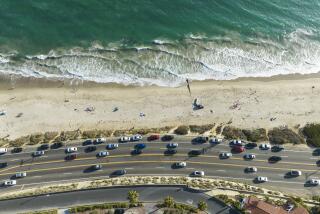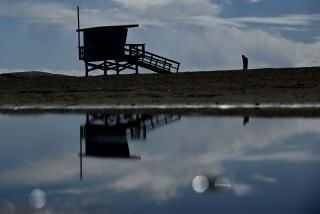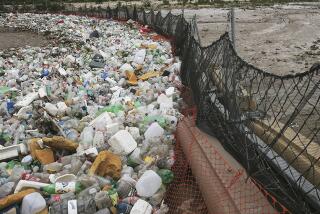Waste-Water Leak Found in Arroyo Conejo
THOUSAND OAKS — Workers replacing part of a faulty sewer line found waste water leaking into the Arroyo Conejo on Monday in the same area where a massive break occurred in February, prompting state and federal probes.
By late Monday, city officials did not know how much sewage had seeped into the arroyo, when the flow began or what prompted the leak about 800 feet upstream from the Hill Canyon Wastewater Treatment Plant.
Contractors, who have been working since July 1 on a $10-million project to replace part of the aging sewer line, were expected to toil late into the night to divert the stream, unearth the buried sewer line and staunch the flow of waste water, City Atty. Mark Sellers said.
“We have reason to believe the flow [from the leak] is nominal at this point,” Sellers said. “All flows and gauges at the treatment plant are working normally. . . . The plant is used to getting 8 million gallons of flow a day, and it’s still getting 8 million gallons a day. So it’s not a big rupture.”
According to a city memo, the leak is in “approximately the same location where the line failed in February 1998,” when El Nino rains washed out the main and sent 86 million gallons of sewage sluicing down the arroyo toward the Pacific.
On Monday, officials with the county Department of Environmental Health and the Los Angeles Regional Water Quality Control Board were notified of the leak. The regional board’s executive officer and another staff member are expected to inspect the leak today.
In two weeks, the city’s lawyers must face the regional board at a hearing regarding regulators’ recommendation that Thousand Oaks be fined $2.1 million for February’s spill.
*
Also, the U.S. attorney’s office is investigating that spill for possible criminal violations of the federal Clean Water Act.
City officials call the February spill, which occurred during an immense rainstorm, an “act of God.” But regional board staff members contend that it was avoidable, particularly because the line had failed before and had long been scheduled for replacement.
Council members reached Monday night referred all questions to the city attorney, citing the state and federal investigations.
However, one noted about Monday’s development, “The timing couldn’t be worse.”
Sellers said the city was working quickly to find the cause and patch the leak.
“The contractor is down there right now evaluating it,” he said Monday night. “We will take the appropriate measures to stop the leak and, particularly, stop the flow from entering into the creek.”
He added, “It’s just getting more attention than it probably should because of the background.”
Elizabeth Huff, manager of community services for the county environmental health department, said signs were posted along the arroyo telling people to avoid the water.
“If we determine that there’s a public health hazard related to the beaches or public recreation areas, then we would post signs” at the beaches, she said. “They’ve indicated that it is minor.”
Raw sewage can contain a number of disease-causing organisms, bacteria and viruses, including salmonella, E. coli and hepatitis, she said. The workers who discovered the leak are in the early stages of a summer-long project to replace the lower reaches of the sewer line--nestled in a narrow, craggy canyon crisscrossed by the arroyo--and to refurbish the existing line for emergency use.
*
A similar project for the upper reaches of the line is planned for next summer.
Both projects were planned before the winter sewer disaster.
The line was first listed for replacement a decade ago. More recently, virtually all repairs to the sewer plant and lines were tied up during a two-year stalemate over a $75-million upgrade to the Hill Canyon plant. That upgrade was approved last year.
Even before any fines are paid, the city has already set aside $675,000 for various legal work and document reproduction related to the February spill and the investigations it prompted.
Folmar is a Times staff writer and Takenouchi is a correspondent.
More to Read
Sign up for Essential California
The most important California stories and recommendations in your inbox every morning.
You may occasionally receive promotional content from the Los Angeles Times.









